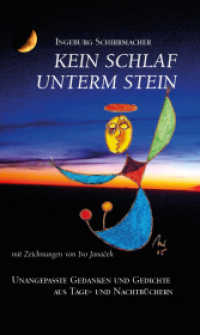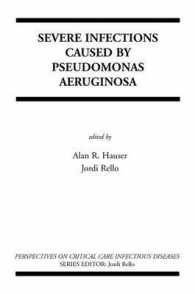- ホーム
- > 洋書
- > 英文書
- > Business / Economics
Full Description
This four-volume primary source collection examines the links between the financial world and British culture in the nineteenth-century. The twenty-first-century financial world had its origins in nineteenth-century Britain with industrialism, imperial expansion, and a robust securities market. New developments in limited liability and financial journalism democratized investment, rendering Victorian Britain a nation of shareholders. The City of London and the London Stock Exchange sat at the very centre of international finance, much as the New York Stock Exchange does today.
The history of nineteenth-century finance is also the history of culture and cultural change. Finance cut across all aspects of life in the nineteenth-century. It was central to many social and political issues, including the "woman question" (should women invest their own money?) and Liberal reform (did a laissez-faire economy adequately protect ordinary investors?) The ups and downs of the stock market were also central to the plots of Victorian novels and plays.
This multi-volume collection of primary source materials, accompanied by extensive editorial commentary, document the origins, growth, and impact of Britain's financial system.
Contents
Volume III: Shareholders and the Culture of Investment
Part 1. Shareholders and Their World
1. David Morier Evans, Speculative Notes and Notes on Speculation (London: Groombridge and Sons, 1864), pp. 141-46.
2. Union Bank of London, Charing Cross Branch, Schedule of Stock and Share Certificates belonging to Mrs. Lewes, 1 May 1879.
3. [W.M. Thackeray], "A Doe in the City," Punch 9 (1 November 1845), p. 191.
4. [Anon.], 'Scenes from the Life of an Unprotected Female', Punch 18 (January 1850), pp. 22-23.
5. [Anon.], 'Dividend Day', All the Year Round (11 November 1893), pp. 462-64.
6. Eastern Counties Railway, Shareholders' Meeting, London Standard (1 March 1849), p. 4.
7. George W. Hemming, 'Railway Shareholders', Saturday Review 1 (1856), pp. 225-26.
8. C.H. Thorpe, How to Invest and How to Speculate (London: Grant Richards, 1901), pp. 65-78.
9. Charlotte Riddell, George Geith of Fen Court, 3 Vols. (London: Tinsley Brothers, 1864), Vol. 1, pp. 43-55.
10. Bracebridge Hemyng, 'Time and Tide Wait for No Man: A Tale of the Tape', The Stockbroker's Wife and Other Sensational Tales of the Stock Exchange (London: John and Robert Maxwell, 1885), pp. 159-72.
11. Alexander Innes Shand, 'Speculative Investments', Blackwood's Magazine 120 (September 1876), pp. 293-316.
Part 2. Advice Books for Investors
12. Thomas Mortimer, Every Man His Own Broker; or, A Guide to the Stock-Exchange, 12th edition (London: W.J. and J. Richardson, 1798), pp. v-xxii.
13. [George G. Carey], A New Guide to the Public Funds; or, Every Man His Own Stock-Broker (London: D.B. Woodward, 1835), pp. 80-90.
14. Gresham Omnium, A Handy Guide to Safe Investments (London: Groombridge and Sons, 1860), pp. 50-69.
15. Arthur Crump, The Theory of Stock Exchange Speculation (London: Longmans, Green, Reader, and Dyer, 1874), pp. 41-60.
16. George Gregory, Hints to Speculators and Investors in Stocks and Shares (London: George Gregory & Co., 1891), pp. 13-21.
17. A.J. Wilson, Practical Hints to Investors and Some Words to Speculators (London: Clement Wilson, 1897), pp. 9-27.
18. [Emma Sophia Galton], Guide to the Unprotected in Everyday Matters Relating to Property and Income by a Banker's Daughter (London: Macmillan and Co., 1863), pp. 9-15.
19. Caroline Haddon, Where Does Your Interest Come From?: A Word to Lady Investors (London: John Heywood, 1886)
Part 3. Financial Journalism and the Money Article
20. George Goschen, 'Seven Per Cent', Edinburgh Review 121 (January 1865), pp. 114-29.
21. Walter Bagehot, 'What to Buy—I: A Series of Popular Articles on Investment', Economist 24 (15 December 1866), pp. 1449-51.
22. Amy Bell, 'How Women May Invest Their Money', Englishwoman's Review (April 1892), pp. 85-87, and (July 1892), pp. 159-61.
23. Olive Malvery, 'Women and the Money Market', The Ladies' Realm 21 (November 1906), pp. 41-5.
24. [Anon.], 'The Sham Financial Press', The Statist (9 April 1887), pp. 389-90.
25. Charles Duguid, How to Read the Money Article (London: Effingham Wilson, 1901), pp. 99-106.
Part 4. Institutional Shareholders and Trusts
26. Samuel Brown, 'On the Investment of the Funds of Assurance Companies', Assurance Magazine 7 (April 1858), pp. 241-54.
27. Board of Trade, Statements of Accounts and Life Assurance and Annuity Business, 1902 (London: HMSO, 1904), p. 2.
28. Augustine Birrell, The Duties and Liabilities of Trustees (London: Macmillan and Co., 1896), pp. 125-39.
29. C.H. Thorpe, How to Invest and How to Speculate (London: Grant Richards, 1901), pp. 104-14.
Part 5. Investors and Imperialism
30. 'The Dangers of Lending to Semi-Civilised Countries', Economist 25 (23 November 1867), pp. 1321-22.
31. George Baden-Powell, Proceedings of the Royal Colonial Institute, Vol. 18 (London: Sampson Low, Marston, Searle and Rivington, 1887), pp. 253-75.
32. [Anon.], The East India Government Guarantee on Railways (London: William H. Allen and Co., 1861), pp. 4-12.
33. Dadabhai Naoroji, Poverty and Un-British Rule in India (London: Swan Sonnenschein and Co., 1901), pp. 33-34, 54-55.
34. Olive Schreiner, Trooper Peter Halket of Mashonaland (London: T. Fisher Unwin, 1897), pp. 13-37.
35. John A. Hobson, Imperialism: A Study (London: James Nisbet and Co., 1902), pp. 56-63.
Index






